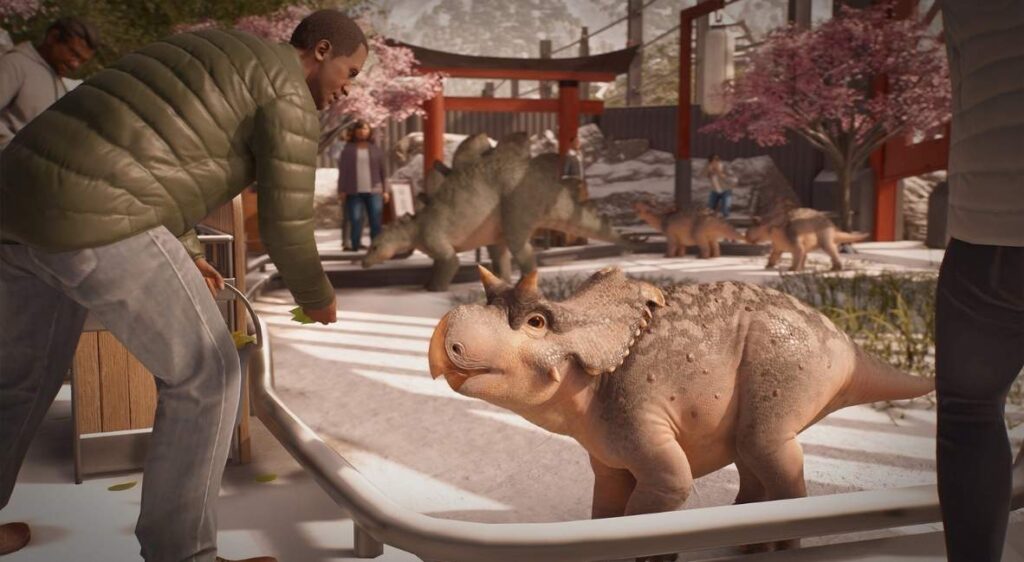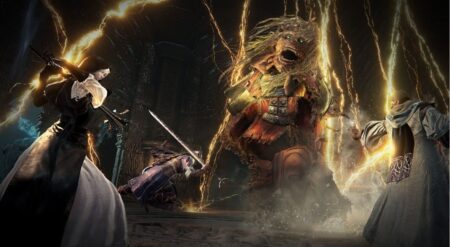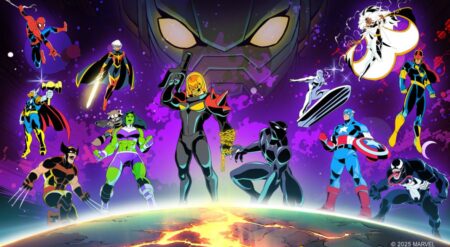Read our interview with the Jurassic World Evolution 3 Game Director, Andy Fletcher.
The Jurassic World Evolution franchise has easily been my favorite of Frontier Developments’ park management titles. With Jurassic World Evolution 3, the game is expanding beyond just a dino park sim. With more robust park building and customization systems, the introduction of an animal husbandry system (and baby, well, juvenile dinosaurs with it), climate disruptions, and balancing new dinosaur enclosure requirements, everything is just more expansive. And that’s a good thing.
Where the other Jurassic World Evolution titles have tasked park managers and their scientists to make new dinosaurs, releasing them into the enclosures at a specific age, this third entry into the franchise is asking you to manage multiple dinosaur generations in one enclosure.
You don’t just have to navigate the foliage and tolerance levels with other species. Now, you also need to manage the gender breakdowns in one enclosure, as well as keep an eye on personality traits that can set off fights even with other dinosaurs that they should be getting along with.
Adding in juvenile dinosaurs is adorable, especially for the chunkier of the species, but it’s also a challenge. Additionally, while you are focused on conservation and protecting dinosaurs by allowing them to breed in captivity, sometimes you need them to stop. With the ability to turn birth control on and off, you’ll need to manage some populations that are outpacing captivity or breeding to the point that the other dinosaurs in the enclosure are struggling to remain in balance.
Jurassic World Evolution 3 offers a wealth of systems to manage that up the immersion from previous titles.
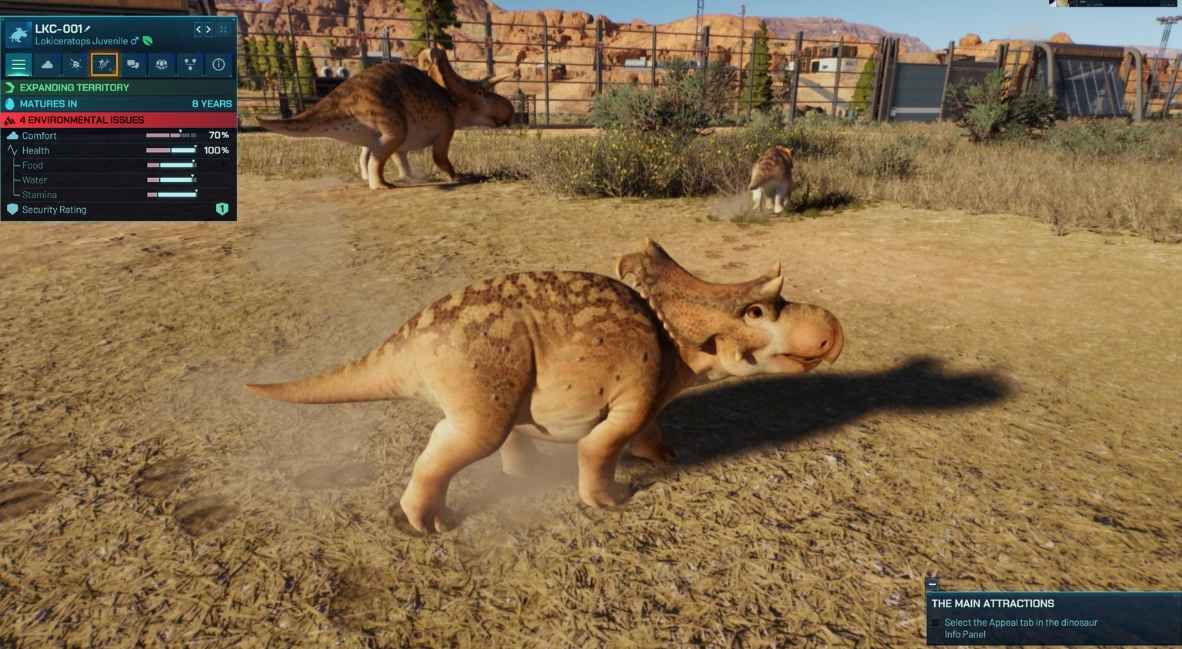
In addition to managing the breeding and balancing the needs of the young and mature dinosaurs, researching genomes from fossils and learning how to edit traits to either overcome species detriments like hostility, hunger, or short lifespans is essential. Over-correcting some detrimental traits is a reality, and also balancing them against the other traits in the enclosure becomes its own dance.
But where the depth of the system comes from traits and how they come up after breeding has begun, the fun part is changing the color of the dinosaurs. The reason I mention this element that may feel insignificant is that for dinosaurs featured in the Jurassic Park and Jurassic World films, they will, for the most part, have a skin variation that reflects how they looked in the film. The triceratops, velociraptor, and dilophosaurus are three of my favorites.
The easter eggs, or rather throwback choices, are also immediately present when you are building your park as well. Of course, there are some Jurassic World staples like the pyramid building and orb tours (I know this isn’t the real name, but hang with me), but you also have the choice to reskin buildings that look like they came out of the 1993 Jurassic Park film as well, instead of needing a DLC to do it.
It’s a choice that allows you to play around in the franchise in an easy and custom way. Add in the different buildings that reflect different regions you head to, and the international feel of the park comes together in a way similar to Planet Zoo.
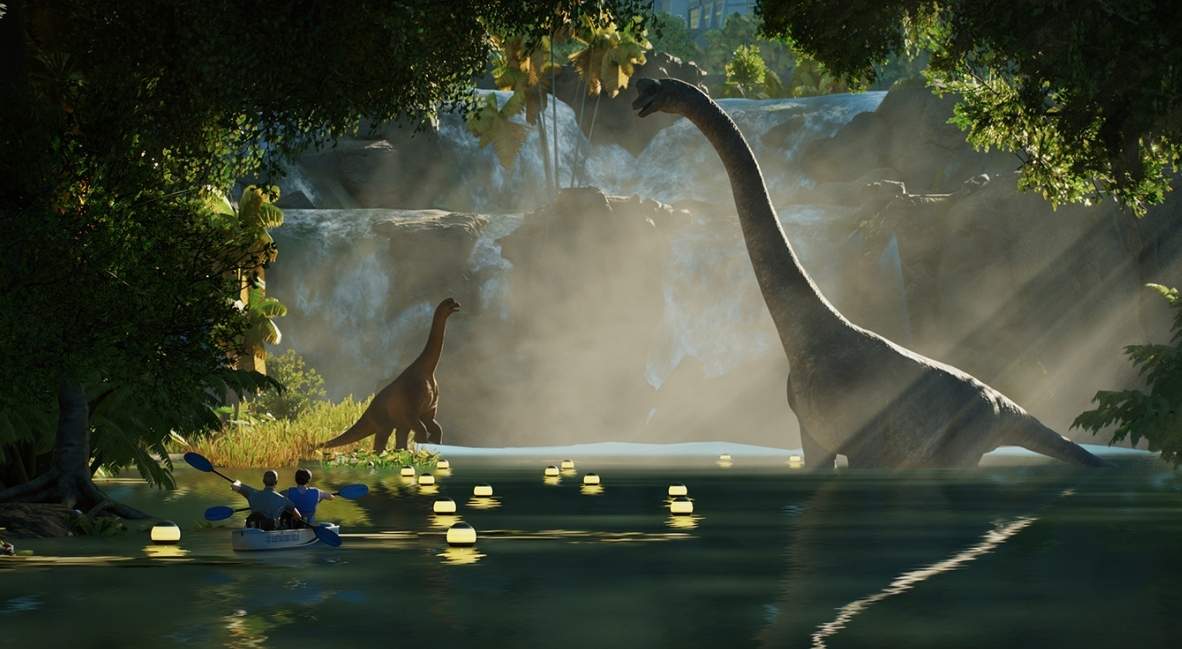
But now comes the fun part: when your dinosaurs eat the guests. Security remains an important element of Jurassic World Evolution 3. This means making sure you use the right fences, keep your generators supplied so nothing breaks, and well, maybe don’t delete a path and then drop an aviary dome on top of it with people still in the area, thinking they will just be auto-removed. They won’t.
In the information tab of your carnivores, you can even see their kill count. While this tab in the dinosaur profile also helps you track their aggressive nature, which can show up as the number of fights they have had, won, and their alpha status, if any, you can also see how many guests they’ve eaten. Fun right? Frontier knows its base.
One of the standouts of my time with Jurassic World Evolution 3 is that the campaign is not lacking in creativity. While you are following a story through different parks, you’re also able to ignore the story objective and just keep building. Maybe you lose track of time and inadvertently wind up with a five-star park and $60 million in revenue without doing the last objective to move forward.
It happens. But that also means that even when playing the campaign, the robust management and building that you’re able to do is comparable to what you can do in sandbox mode. In fact, Jurassic World Evolution 3 is one of the few builder/management games that I didn’t even bother touching the sandbox until the very end.
Creativity is the heart of Jurassic World Evolution 3.
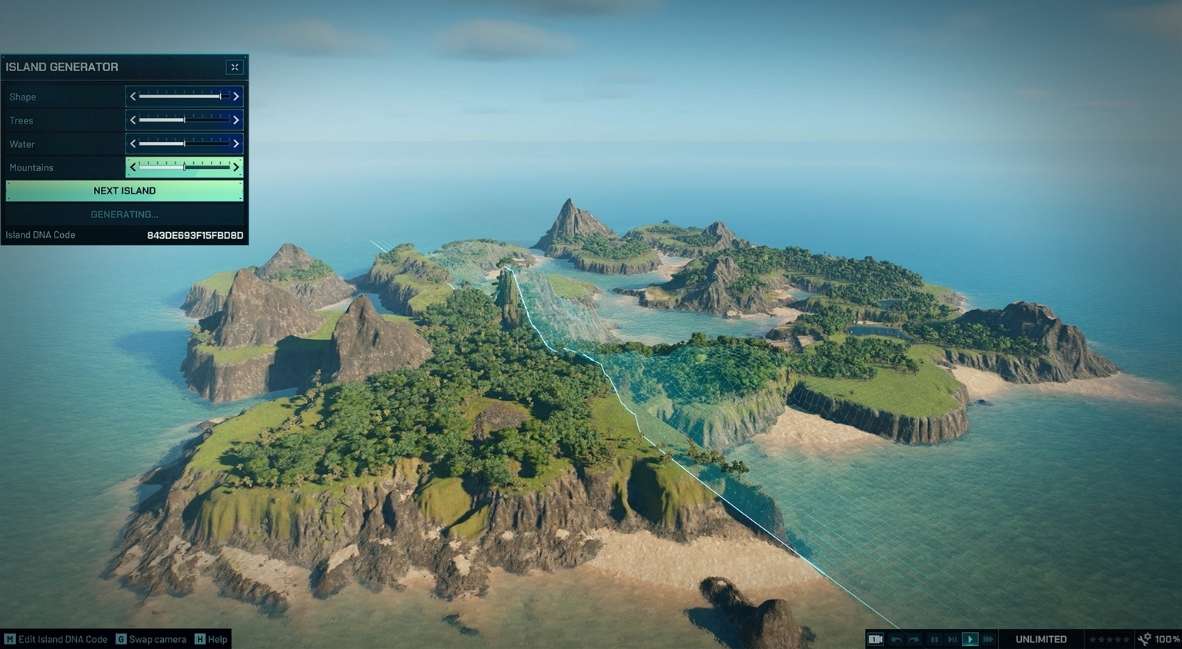
Once you unlock new parks, the campaign allows you to explore the world so much and with little restraint, making it easy to build the park that you want. Add in the expanded suite of terrain controls, and you can turn even an existing park you’re renovating into something just for you. Or, rather, you and thousands of guests. That said, when you are in the sandbox, the ability to create your island just as you want it is really a fantastic feat. Everything here is about player agency.
Jurassic World Evolution 3 promises creativity, and, in practice, it doesn’t get any better than this. By switching to a modular building system, you’re able to alter the existing buildings in the menu (like, let’s say, a small hotel) with different doors, pools, and the like. Additionally, for all of the blank space left between paths and buildings, you can use the scenery tool to build new, unique items, too. Use the tool to build a unique fountain or building – anything you desire to create.
The limitless creativity does a significant amount of work in allowing the player to stay immersed. As I worked through the campaign, I was editing my hotel block and did not look at the economy or dinosaurs because I had everything in a great set it and forget it state. However, when I looked up, I saw that I had customized everything, and I had amassed more than $10 million. I just lost myself in the tiny specificities of the building and the path in front of it that I forgot about everything else.
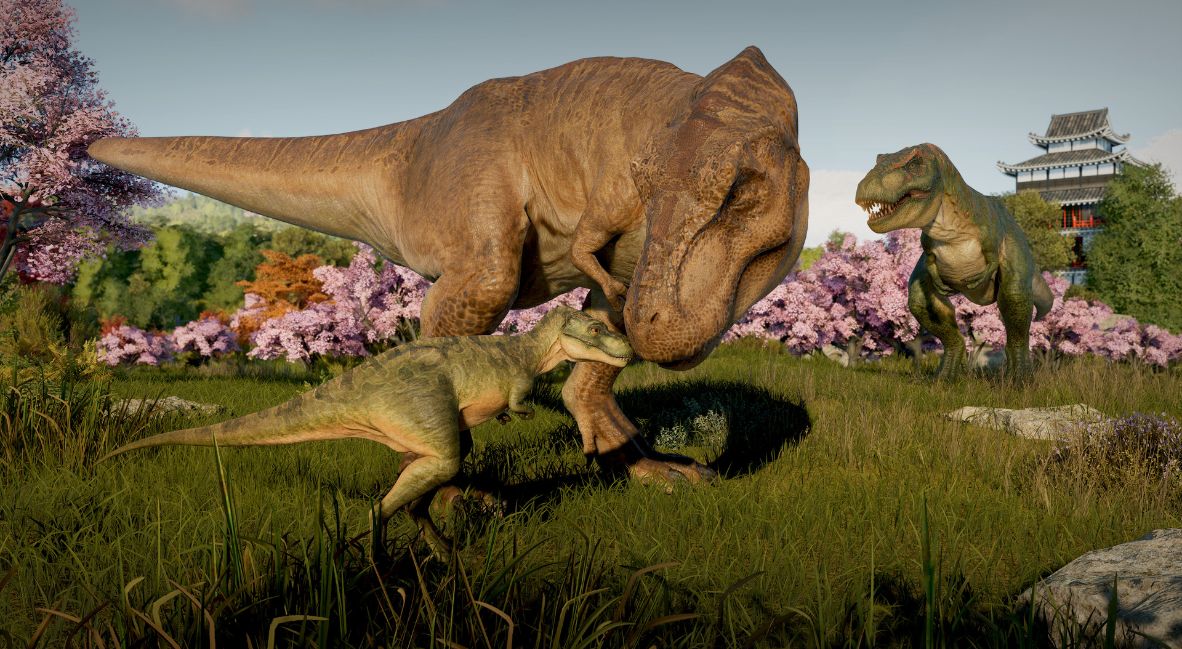
While there was potential for worry that Jurassic World Evolution 3 would be too much like Planet Zoo when it introduced juvenile dinosaurs, that isn’t the case. Part of that is because the mechanics of park management are fundamentally different. The other reason is because of how deep the customization system works for the player to curate their park aesthetic at such a granular level that no two parks will be alike.
The amount of player choice and creativity found in Jurassic World Evolution 3 showcased just how far the franchise has come. More importantly, how well Frontier Developments understands its management sim audience to roll out a suite of features that target the smallest elements of a park but offer big rewards for the players who are always looking to dive deeper.
With so much to customize and create, the replayability, even in the campaign, is an immediate standout. Add in the diversity of dinosaur types, even within species, and more giants available than ever before, and the effect is thrilling. Build tanks, aviaries, and wide open spaces just the same.
On the other hand, if you’re too intimidated by building things from the ground up or altering buildings, you can use the blueprints section of scenery, which has a number of items (fountains, buildings, etc.) that you can use to fill out your park. Learn how to build and share your custom designs with the wider playerbase, or just vibe and stay on the surface. It’s your choice to make, and the exciting thing is that Jurassic World Evolution 3 doesn’t penalize you for going either way.
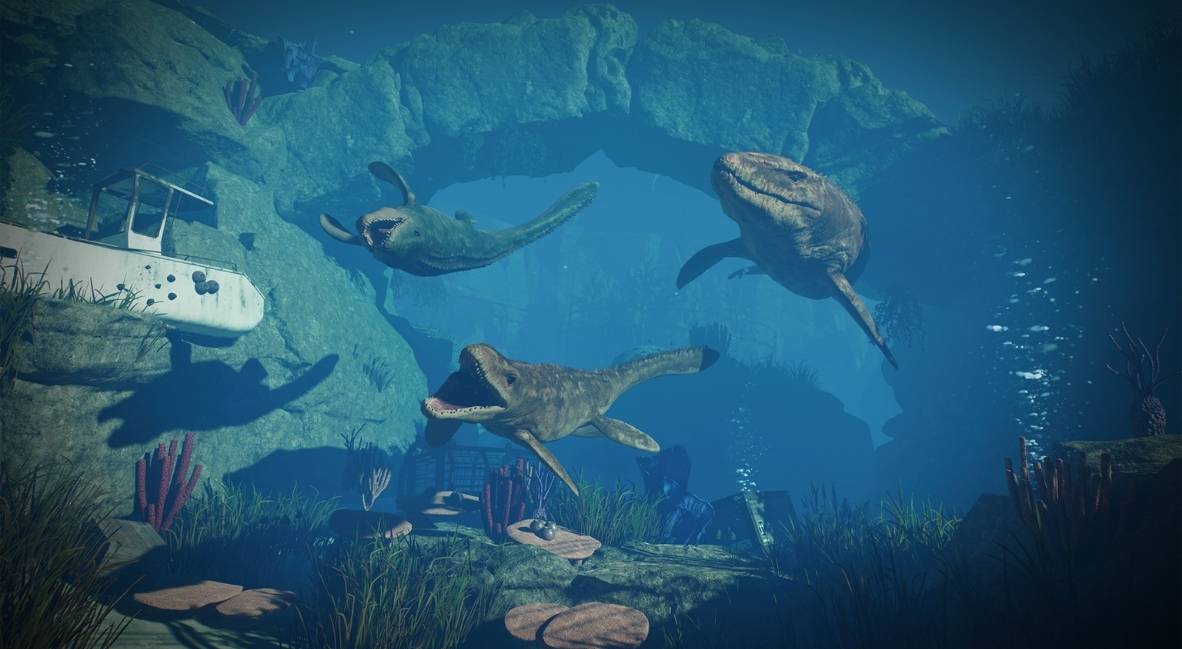
In the way of customization, editing has also simplified with new brush mechanics that allow you to paint whole swatches of land to varying intensities, adjusted via a slider, instead of requiring you to place individual plants or rocks. Additionally, the act of replacing elements like a path has been simplified with the same brush mechanic, allowing you to quickly swap out paths without having to do it one by one.
As the third game in the franchise, Jurassic World Evolution 3 has built on the previous titles while also setting itself apart. When it comes to park management, Frontier Developments knows what it’s doing. Still, for the Jurassic Evolution series, the ability to work a campaign into a larger cinematic universe is what makes it stand out. While the storytelling itself isn’t exactly groundbreaking, I challenge anyone to find a tie-in game that does more to make the player feel like they’re a part of the world.
Part of this comes through Ian Malcolm commenting on your genome alterations, especially when you unlock hybrid dinosaurs. Still, more widely, it’s the scientists talking about the world around you, establishing the world you’re building in. Conservation becomes a focal point, but also understanding what Jurassic World: Dominion did to the world is tantamount. You’re running a dinosaur park, but you’re running one within one of the most beloved franchises. Sure, this is a hit at nostalgia, but the campaign itself and the different parts of the world you go to make it all feel grounded.
Frontier Developments has expanded on the management sim franchise that taps into a nostalgic love of dinosaurs.
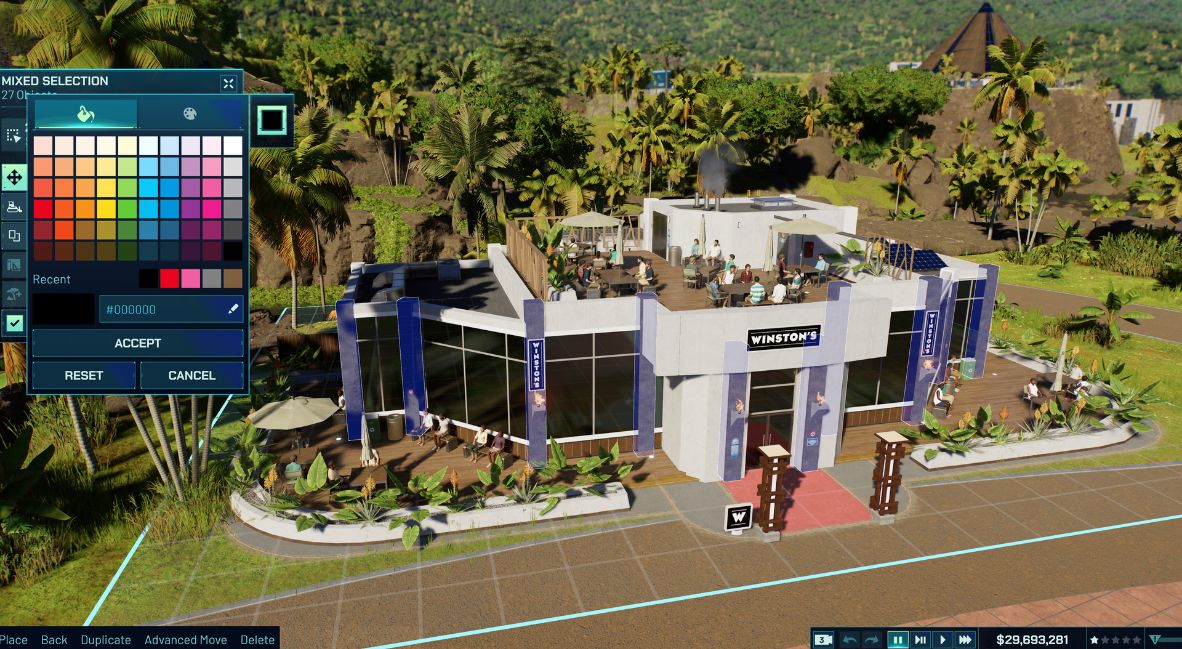
Jurassic World Evolution 3 doesn’t limit itself to the pre-existing rules of the franchise’s universe, instead allowing you, the player, to expand it. Jurassic World Evolution 3 is immersive because it taps into the love we all had as kids for dinosaurs. Still, the polish it has around storytelling and system depth makes it a game that thrives even without being attached to a current film.
Frontier Developments has made its name with park management sims, and each one, regardless of franchise, has worked to push its next project. Jurassic World Evolution 3 feels like the direct sequel its franchise needed to expand for the better, while also being the perfect spiritual sequel to Planet Zoo, iterating on systems introduced in that title but making it unique to the IP at the same time.
Jurassic World Evolution 3 is an astounding management sim and was released in a year with great games also coming out in the genre. The franchise it’s attached to is the cherry on top of what is both an approachable but deep game that always asks you to learn more, but in an accessible way.
Where you may start out not engaging with every system, the tutorialization that the game offers will quickly build your confidence to take the next step and try different things. It’s hard to be both a great introductory game into management sims and also offer the die-hards a level of depth that doesn’t leave them wanting, but Jurassic World Evolution 3 does it perfectly.
Jurassic World Evolution 3 is available now on PC, Xbox Series X|S, and PlayStation 5.
Jurassic World Evolution 3
-
Rating - 9.5/109.5/10
TL;DR
It’s hard to be both a great introductory game into management sims and also offer the die-hards a level of depth that doesn’t leave them wanting, but Jurassic World Evolution 3 does it perfectly.

